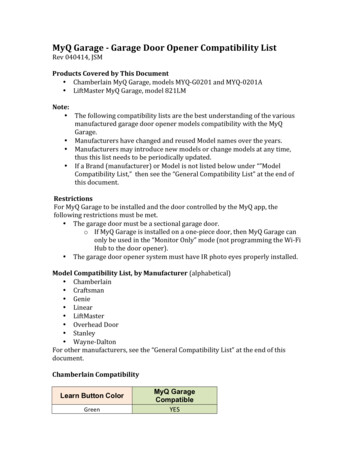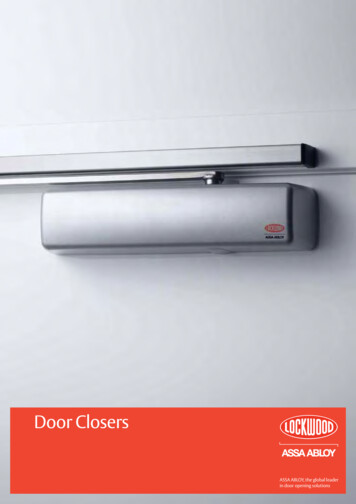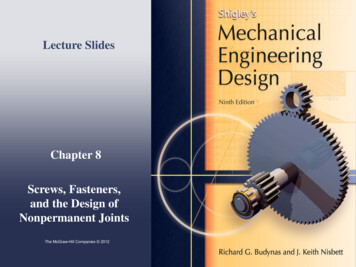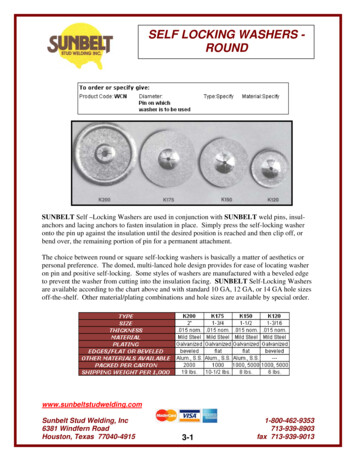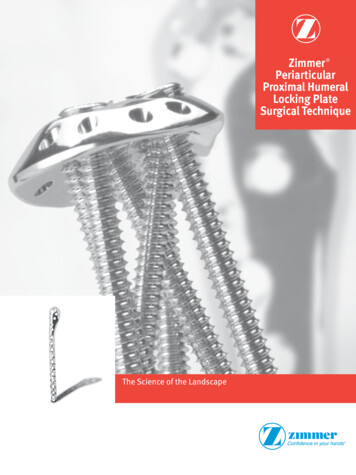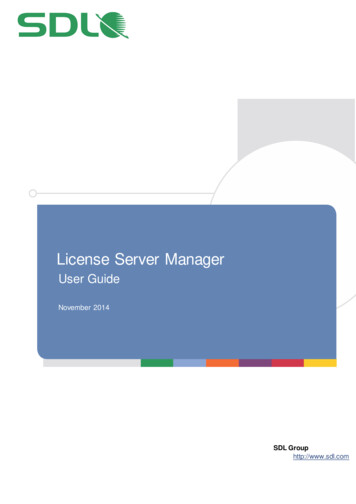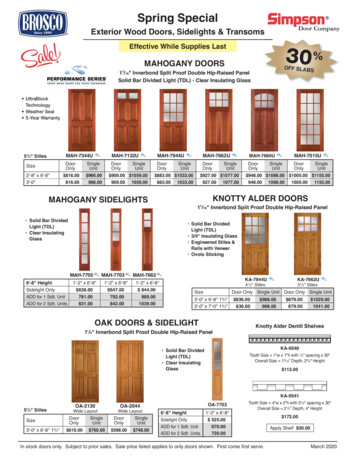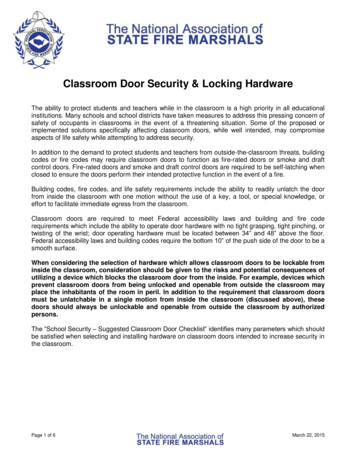
Transcription
Classroom Door Security & Locking HardwareThe ability to protect students and teachers while in the classroom is a high priority in all educationalinstitutions. Many schools and school districts have taken measures to address this pressing concern ofsafety of occupants in classrooms in the event of a threatening situation. Some of the proposed orimplemented solutions specifically affecting classroom doors, while well intended, may compromiseaspects of life safety while attempting to address security.In addition to the demand to protect students and teachers from outside-the-classroom threats, buildingcodes or fire codes may require classroom doors to function as fire-rated doors or smoke and draftcontrol doors. Fire-rated doors and smoke and draft control doors are required to be self-latching whenclosed to ensure the doors perform their intended protective function in the event of a fire.Building codes, fire codes, and life safety requirements include the ability to readily unlatch the doorfrom inside the classroom with one motion without the use of a key, a tool, or special knowledge, oreffort to facilitate immediate egress from the classroom.Classroom doors are required to meet Federal accessibility laws and building and fire coderequirements which include the ability to operate door hardware with no tight grasping, tight pinching, ortwisting of the wrist; door operating hardware must be located between 34” and 48” above the floor.Federal accessibility laws and building codes require the bottom 10” of the push side of the door to be asmooth surface.When considering the selection of hardware which allows classroom doors to be lockable frominside the classroom, consideration should be given to the risks and potential consequences ofutilizing a device which blocks the classroom door from the inside. For example, devices whichprevent classroom doors from being unlocked and openable from outside the classroom mayplace the inhabitants of the room in peril. In addition to the requirement that classroom doorsmust be unlatchable in a single motion from inside the classroom (discussed above), thesedoors should always be unlockable and openable from outside the classroom by authorizedpersons.The “School Security – Suggested Classroom Door Checklist” identifies many parameters which shouldbe satisfied when selecting and installing hardware on classroom doors intended to increase security inthe classroom.Page 1 of 6March 22, 2015
School Security – Suggested Classroom Door Checklist The door should be lockable from inside the classroom without requiring the door to be opened1 Egress from the classroom through the classroom door should be without the use of a key, atool, special knowledge, or effort2 For egress, unlatching the classroom door from inside the classroom should be accomplishedwith one operation3 The classroom door should be lockable and unlockable from outside the classroom4 Door operating hardware shall be operable without tight grasping, tight pinching, or twisting ofthe wrist5 Door hardware operable parts should be located between 34 and 48 inches above the floor6 The bottom 10 inches of the “push” side of the door surface should be smooth7 If the school building does not have an automatic fire sprinkler system, the classroom door anddoor hardware may be required to be fire-rated and the door should be self-closing and selflatching8 If the door is required to be fire-rated, the door should not be modified in any way thatinvalidates the required fire-rating of the door and / or door hardware9In the Suggested Classroom Door Checklist, “should” is used throughout. However, based uponbuilding codes, life safety codes, fire codes, and federal, state, and / or local laws and regulations thatare applicable to a particular school, these requirements may be MANDATORY.Always check, and comply with, all applicable building and fire codes, life safety codes, and laws,regulations and other requirements.1To help protect teachers and students in the classroom, the classroom door should be lockable from in theclassroom without requiring the door to be opened.2Building codes, life safety codes, and fire codes require doors in the means of egress to be openable without theuse of a key, a tool, special knowledge, or effort to ensure all occupants have the ability to evacuate the buildingquickly and easily in an emergency situation3Building codes and fire codes require doors in the means of egress to be unlatched with only one operation.Door hardware which requires more than one operation to unlock / unlatch the door is not allowed.4To allow securing the classroom during times the classroom is not occupied; and to allow access to theclassroom at all times by authorized personnel.5Building codes, fire codes, and Federal accessibility laws require door hardware to be operable without tightgrasping, pinching, or twisting of wrist to ensure all occupants have the ability to operate and open the door.6Building codes, fire codes, and Federal accessibility laws require the operable components of door hardware,such as lockset lever handles, to be located within a relatively small range of height (34” to 48” above the floor).Door hardware which requires reaching above 48” to operate or requires reaching below 34” to operate is notallowed.7Building codes and Federal accessibility laws require the bottom 10” of the push side of the door to be a smoothsurface.8If the school building is not protected by a fire sprinkler system installed and maintained in accordance withbuilding and fire code requirements, most building codes and fire codes require classroom doors which open toan interior corridor to be fire-rated. Doors required to be fire-rated are also required to be self-closing and selflatching to ensure the fire-rated door is closed and latched in the event of a fire. Classroom doors that opendirectly to the outside are usually not be required to be fire-rated. Classroom doors in a school building protectedby a code-compliant fire sprinkler system may not be required to be fire-rated, and may not be required to be selfclosing and self-latching.9To ensure the fire rating of a door is maintained, modifications or alterations to doors required to be fire-ratedare required to be done under the supervision of the door manufacturer or by a company specifically authorizedby the door manufacturer.Page 2 of 6March 22, 2015
References for Suggested Classroom Door Checklist1st Item in Checklist Assumes increasing the security of classroom doors by adding hardware that is lockable fromthe inside is under consideration; and assumes if this is not the situation, then this document isirrelevant. Is consistent with Recommendation No. 1 of the “Final Report of the Sandy Hook AdvisoryCommission”, March 6, 2015, available here: http://www.shac.ct.gov/SHAC Final Report 3-62015.pdf and copied below.RECOMMENDATION NO. 1: The SSIC Report includes a standard requiring classroomand other safe-haven areas to have doors that can be locked from the inside. TheCommission cannot emphasize enough the importance of this recommendation. Thetestimony and other evidence presented to the Commission reveals that there has neverbeen an event in which an active shooter breached a locked classroom door.Accordingly, the Commission reiterates its recommendation that all classrooms in K-12schools should be equipped with locked doors that can be locked from the inside by theclassroom teacher or substitute. The “SSIC report” (School Safety Infrastructure Council report) is available rt%20June27.pdf2nd Item in Checklist The requirements of these International Building Code (IBC) and International Fire Code (IFC)codes are pasted below.o 2006 IBC Section 1008.1.8o 2006 IFC Section 1008.1.8o 2009 IBC Section 1008.1.9o 2009 IFC Section 1008.1.9o 2012 IBC Section 1008.1.9o 2012 IFC Section 1008.1.9o 2015 IBC Section 1010.1.9o 2015 IFC Section 1010.1.9Door operations. Except as specifically permitted by this section egress doors shall be readilyopenable from the egress side without the use of a key or special knowledge or effort. Requirements of Section 7.2.1.5.3 of 2012 NFPA 101 Life Safety Code, and Section 7.2.1.5.3 of2015 NFPA 101 Life Safety Code:7.2.1.5.3 Locks, if provided, shall not require the use of a key, a tool, or special knowledge oreffort for operation from the egress side.3rd Item in Checklist The requirements of these International Building Code (IBC) and International Fire Code (IFC)codes are pasted below.o 2006 IBC Section 1008.1.8.5o 2006 IFC Section 1008.1.8.5o 2009 IBC Section 1008.1.9.5o 2009 IFC Section 1008.1.9.5o 2012 IBC Section 1008.1.9.5o 2012 IFC Section 1008.1.9.5o 2015 IBC Section 1010.1.9.5o 2015 IFC Section 1010.1.9.5Page 3 of 6March 22, 2015
Unlatching. The unlatching of any door or leaf shall not require more than one operation. Requirements of Section 7.2.1.5.10 of 2012 NFPA 101 Life Safety Code, and Section 7.2.1.5.10of 2015 NFPA 101 Life Safety Code:7.2.1.5.10* A latch or other fastening device on a door leaf shall be provided with a releasingdevice that has an obvious method of operation and that is readily operated under all lightingconditions.7.2.1.5.10.2 The releasing mechanism shall open the door leaf with not more than one releasingoperation . . . .4th Item in Checklist Criteria 6.15 of the SSIC standards provided in the draft “Final Report of the Sandy HookAdvisory Commission” require classroom doors to “allow for quick release in the event of anemergency”:6.15. Classroom door locks shall be easy to lock and allow for quick release in the event of anemergency.5th Item in Checklist The requirements of these International Building Code (IBC) and International Fire Code (IFC)codes are pasted below.o 2006 IBC Section 1008.1.8.1o 2009 IBC Section 1008.1.9.1o 2012 IBC Section 1008.1.9.1o 2015 IBC Section 1010.1.9.1Hardware. Door handles, pulls, latches, locks and other operating devices on doors required tobe accessible by Chapter 11 shall not require tight grasping, tight pinching or twisting of thewrist to operate.oooo2006 IFC Section 1008.1.8.12009 IFC Section 1008.1.9.12012 IFC Section 1008.1.9.12015 IFC Section 1010.1.9.1Hardware. Door handles, pulls, latches, locks and other operating devices on doors required tobe accessible by Chapter 11 of the International Building Code shall not require tight grasping,tight pinching or twisting of the wrist to operate. The U.S. Department of Justice 2010 ADA Standards for Accessible Design are applicable toclassroom doors.404.2.7 Door and Gate Hardware. Handles, pulls, latches, locks, and other operable parts ondoors and gates shall comply with 309.4.309.4 Operation. Operable parts shall be operable with one hand and shall not require tightgrasping, pinching, or twisting of the wrist.Page 4 of 6March 22, 2015
6th Item in Checklist The requirements of these International Building Code (IBC) and International Fire Code (IFC)codes are pasted below.o 2006 IBC Section 1008.1.8.2o 2006 IFC Section 1008.1.8.2o 2009 IBC Section 1008.1.9.2o 2009 IFC Section 1008.1.9.2o 2012 IBC Section 1008.1.9.2o 2012 IFC Section 1008.1.9.2o 2015 IBC Section 1010.1.9.2o 2015 IFC Section 1010.1.9.2Hardware height. Door handles, pulls, latches, locks and other operating devices shall beinstalled 34 inches (864 mm) minimum and 48 inches (1219 mm) maximum above the finishedfloor. Requirements of Section 7.2.1.5.10.1 of 2012 NFPA 101 Life Safety Code, and Section7.2.1.5.10.1 of 2015 NFPA 101 Life Safety Code:7.2.1.5.10.1 The releasing mechanism for any latch shall be located as follows:(1) Not less than 34 in. (865 mm) above the finished floor for other than existing installations(2) Not more than 48 in. (1220 mm) above the finished floor. The U.S. Department of Justice 2010 ADA Standards for Accessible Design are applicable toclassroom doors.404.2.7 Door and Gate Hardware. Handles, pulls, latches, locks, and other operable parts ondoors and gates shall comply with 309.4. Operable parts of such hardware shall be 34 inches(865 mm) minimum and 48 inches (1220 mm) maximum above the finish floor or ground.7th Item in Checklist The requirements of these International Building Code (IBC) codes are pasted below.o 2006 IBC Section 1008.1.8.5o 2009 IBC Section 1008.1.9.5o 2012 IBC Section 1008.1.9.5o 2015 IBC Section 1010.1.9.51101.2 Design. Buildings and facilities shall be designed and constructed to be accessible inaccordance with this code and ICC A117.1.The 2006 and 2009 editions of the IBC reference the 2003 ICC A117.1; the 2012 and 2015editions of the IBC reference the 2009 ICC A117.1. Both these editions of ICC A117.1 require:404.2.9 Door Surface. Door surfaces within 10 inches (255 mm) of the floor, measuredvertically, shall be a smooth surface on the push side extending the full width of the door. The U.S. Department of Justice 2010 ADA Standards for Accessible Design are applicable toclassroom doors.404.2.10 Door and Gate Surfaces. Swinging door and gate surfaces within 10 inches (255mm) of the finish floor or ground measured vertically shall have a smooth surface on the pushside extending the full width of the door or gate.Page 5 of 6March 22, 2015
8th and 9th Items in Checklist The 2006 IBC in Chapter 10 requires corridors in Occupancy Group E to have a fire resistancerating of 1 hour (if the occupant load served by the corridor is greater than 30) if the buildingdoes not have an approved fire sprinkler system. This section of the 2006 IBC requires thesecorridor walls to comply with the requirements for fire partitions of Section 708.o 2006 IBC Section 708 requires openings in corridors to be protected by openingprotectives complying with IBC Section 715.o 2006 IBC Section 715 requires fire doors to be self-closing, and to have an active latchwhich will secure the door when closed.o 2006 IBC Section 715 requires minimum 20 minute rated fire doors in corridor wallsserving as fire partitions. Section 715 requires these fire rated doors to comply withNFPA 252 or UL 10C, and requires fire door assemblies to be labeled by an approvedagency. The labels are required to comply with NFPA 80.o Summarizing: If the classroom doors to the corridor are required to be fire rated, then theclassroom doors – assembled of only labeled components such as frame, door panel,and door hardware with minimum 20 minute fire rating – are required to be self-closingand self-latching, and are to be modified only when following the procedures andrequirements of the door manufacturer and / or hardware manufacturer to ensure therequired fire rating is maintained. The 2006 IFC in Section 703 requires the required fire-resistance rating to be maintained. Subsequent editions of the IBC and IFC retain these requirements but the specific sections arerevised.Page 6 of 6March 22, 2015
Classroom Door Security & Locking Hardware The ability to protect students and teachers while in the classroom is a high priority in all educational institutions. Many schools and school districts have taken measures to address this pressing concern of . implemented solutions specifically affecting classroom doors, while well intended, may .
